用主动形式表示被动意义的词
- 格式:doc
- 大小:24.50 KB
- 文档页数:1
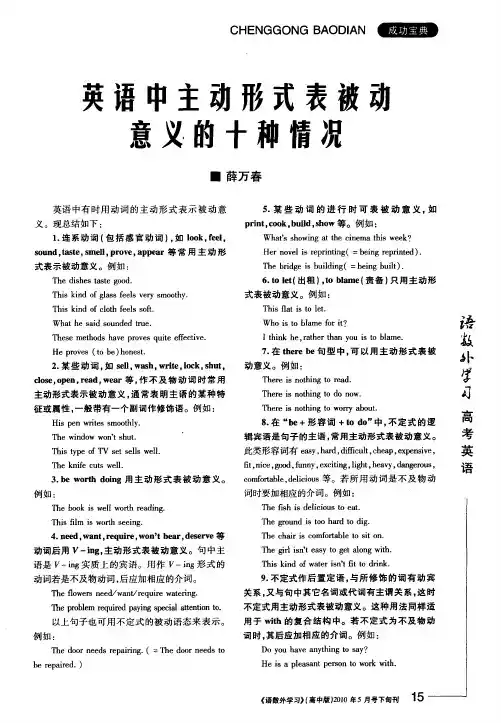
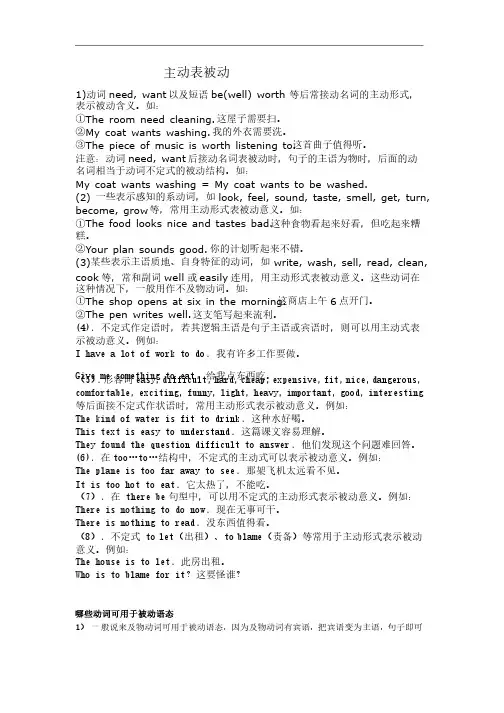
主动表被动主动表被动1)动词need, want 以及短语be(well) worth 等后常接动名词的主动形式,表示被动含义。
如:表示被动含义。
如:①The room need cleaning. 这屋子需要扫。
这屋子需要扫。
②My coat wants washing. 我的外衣需要洗。
我的外衣需要洗。
③The piece of music is worth listening to. 这首曲子值得听。
这首曲子值得听。
注意:动词need, want 后接动名词表被动时,句子的主语为物时,后面的动名词相当于动词不定式的被动结构。
如:名词相当于动词不定式的被动结构。
如:My coat wants washing = My coat wants to be washed.(2) 一些表示感知的系动词,如look, feel, sound, taste, smell, get, turn,become, grow 等,常用主动形式表被动意义。
如:等,常用主动形式表被动意义。
如:①The food looks nice and tastes bad. 这种食物看起来好看,但吃起来糟糕。
糕。
②Your plan sounds good. 你的计划听起来不错。
你的计划听起来不错。
(3)某些表示主语质地、自身特征的动词,如write, wash, sell, read, clean, cook 等,常和副词well 或easily 连用,用主动形式表被动意义。
这些动词在这种情况下,一般用作不及物动词。
如:这种情况下,一般用作不及物动词。
如:①The shop opens at six in the morning.这商店上午6点开门。
点开门。
②The pen writes well. 这支笔写起来流利。
(4)(4).不定式作定语时,若其逻辑主语是句子主语或宾语时,则可以用主动式表.不定式作定语时,若其逻辑主语是句子主语或宾语时,则可以用主动式表示被动意义。
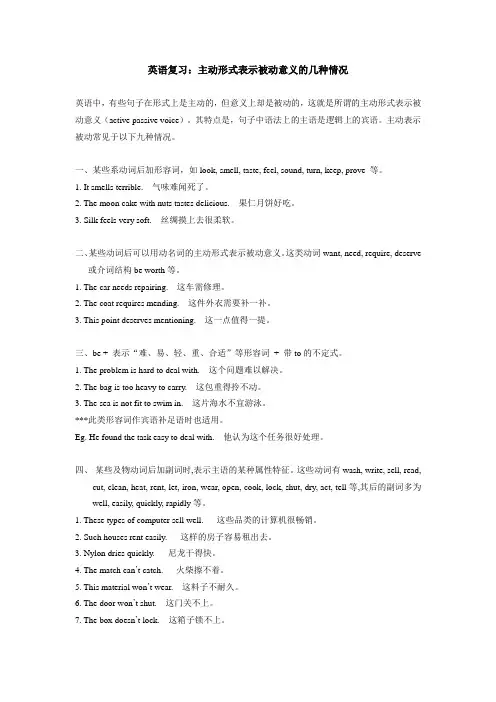
英语复习:主动形式表示被动意义的几种情况英语中,有些句子在形式上是主动的,但意义上却是被动的,这就是所谓的主动形式表示被动意义(active passive voice)。
其特点是,句子中语法上的主语是逻辑上的宾语。
主动表示被动常见于以下九种情况。
一、某些系动词后加形容词,如look, smell, taste, feel, sound, turn, keep, prove 等。
1. It smells terrible. 气味难闻死了。
2. The moon cake with nuts tastes delicious. 果仁月饼好吃。
3. Silk feels very soft. 丝绸摸上去很柔软。
二、某些动词后可以用动名词的主动形式表示被动意义。
这类动词want, need, require, deserve或介词结构be worth等。
1. The car needs repairing. 这车需修理。
2. The coat requires mending. 这件外衣需要补一补。
3. This point deserves mentioning. 这一点值得一提。
三、be + 表示“难、易、轻、重、合适”等形容词+ 带to的不定式。
1. The problem is hard to deal with. 这个问题难以解决。
2. The bag is too heavy to carry. 这包重得拎不动。
3. The sea is not fit to swim in. 这片海水不宜游泳。
***此类形容词作宾语补足语时也适用。
Eg. He found the task easy to deal with. 他认为这个任务很好处理。
四、某些及物动词后加副词时,表示主语的某种属性特征。
这些动词有wash, write, sell, read,cut, clean, heat, rent, let, iron, wear, open, cook, lock, shut, dry, act, tell等,其后的副词多为well, easily, quickly, rapidly等。
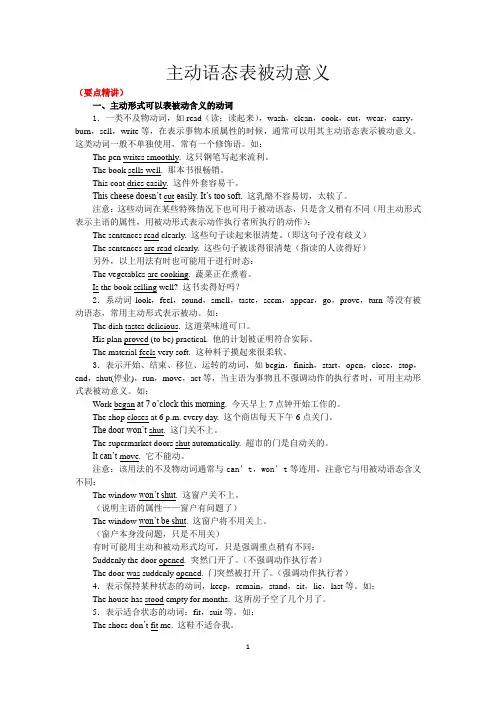
主动语态表被动意义(要点精讲)一、主动形式可以表被动含义的动词1.一类不及物动词,如read(读;读起来),wash,clean,cook,cut,wear,carry,burn,sell,write等,在表示事物本质属性的时候,通常可以用其主动语态表示被动意义。
这类动词一般不单独使用,常有一个修饰语。
如:The pen writes smoothly. 这只钢笔写起来流利。
The book sells well. 那本书很畅销。
This coat dries easily. 这件外套容易干。
This cheese doesn’t cut easily. It’s too soft. 这乳酪不容易切,太软了。
注意:这些动词在某些特殊情况下也可用于被动语态,只是含义稍有不同(用主动形式表示主语的属性,用被动形式表示动作执行者所执行的动作):The sentences read clearly. 这些句子读起来很清楚。
(即这句子没有歧义)The sentences are read clearly. 这些句子被读得很清楚(指读的人读得好)另外,以上用法有时也可能用于进行时态:The vegetables are cooking. 蔬菜正在煮着。
Is the book selling well? 这书卖得好吗?2.系动词look,feel,sound,smell,taste,seem,appear,go,prove,turn等没有被动语态,常用主动形式表示被动。
如:The dish tastes delicious. 这道菜味道可口。
His plan proved (to be) practical. 他的计划被证明符合实际。
The material feels very soft. 这种料子摸起来很柔软。
3.表示开始、结束、移位、运转的动词,如begin,finish,start,open,close,stop,end,shut(停业),run,move,act等,当主语为事物且不强调动作的执行者时,可用主动形式表被动意义。
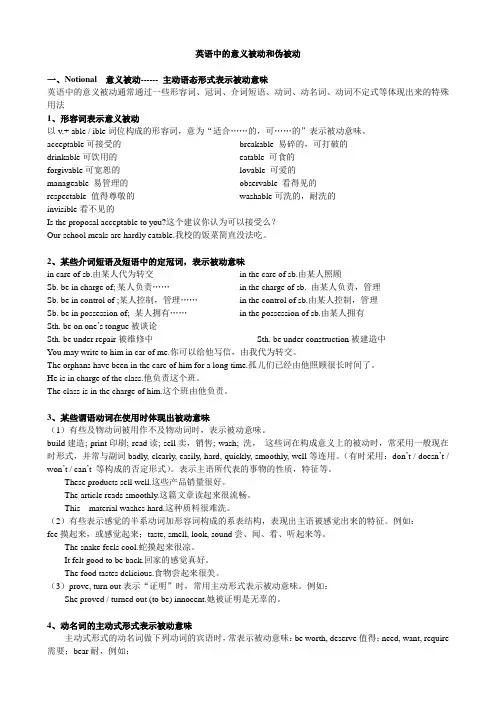
英语中的意义被动和伪被动一、Notional 意义被动------ 主动语态形式表示被动意味英语中的意义被动通常通过一些形容词、冠词、介词短语、动词、动名词、动词不定式等体现出来的特殊用法1、形容词表示意义被动以v.+ able / ible词位构成的形容词,意为“适合……的,可……的”表示被动意味。
acceptable可接受的breakable 易碎的,可打破的drinkable可饮用的eatable 可食的forgivable可宽恕的lovable 可爱的manageable 易管理的observable 看得见的respectable 值得尊敬的washable可洗的,耐洗的invisible看不见的Is the proposal acceptable to you?这个建议你认为可以接受么?Our school meals are hardly eatable.我校的饭菜简直没法吃。
2、某些介词短语及短语中的定冠词,表示被动意味in care of sb.由某人代为转交in the care of sb.由某人照顾Sb. be in charge of; 某人负责……in the charge of sb. 由某人负责,管理Sb. be in control of ;某人控制,管理……in the control of sb.由某人控制,管理Sb. be in possession of; 某人拥有……in the possession of sb.由某人拥有Sth. be on one’s tongue被谈论Sth. be under repair被维修中Sth. be under construction被建造中You may write to him in car of me.你可以给他写信,由我代为转交。
The orphans have been in the care of him for a long time.孤儿们已经由他照顾很长时间了。
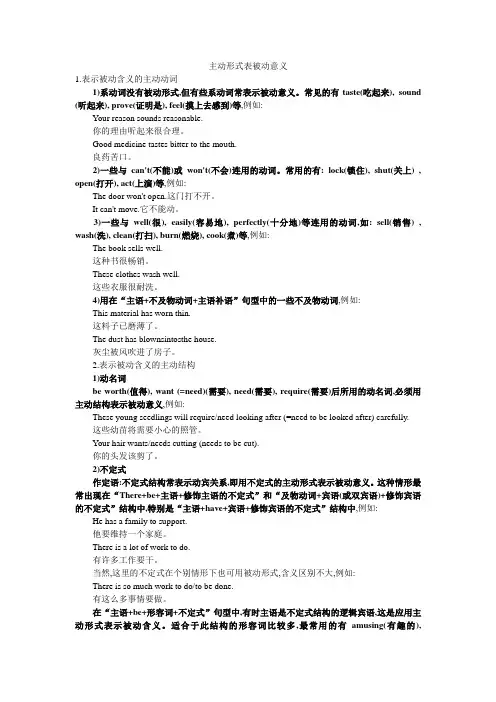
主动形式表被动意义1.表示被动含义的主动动词1)系动词没有被动形式,但有些系动词常表示被动意义。
常见的有taste(吃起来), sound (听起来), prove(证明是), feel(摸上去感到)等,例如:Your reason sounds reasonable.你的理由听起来很合理。
Good medicine tastes bitter to the mouth.良药苦口。
2)一些与can't(不能)或won't(不会)连用的动词。
常用的有: lock(锁住), shut(关上) , open(打开), act(上演)等,例如:The door won't open.这门打不开。
It can't move.它不能动。
3)一些与well(很), easily(容易地), perfectly(十分地)等连用的动词,如: sell(销售) , wash(洗), clean(打扫), burn(燃烧), cook(煮)等,例如:The book sells well.这种书很畅销。
These clothes wash well.这些衣服很耐洗。
4)用在“主语+不及物动词+主语补语”句型中的一些不及物动词,例如:This material has worn thin.这料子已磨薄了。
The dust has blownsintosthe house.灰尘被风吹进了房子。
2.表示被动含义的主动结构1)动名词be worth(值得), want (=need)(需要), need(需要), require(需要)后所用的动名词,必须用主动结构表示被动意义,例如:These young seedlings will require/need looking after (=need to be looked after) carefully.这些幼苗将需要小心的照管。
Your hair wants/needs cutting (needs to be cut).你的头发该剪了。
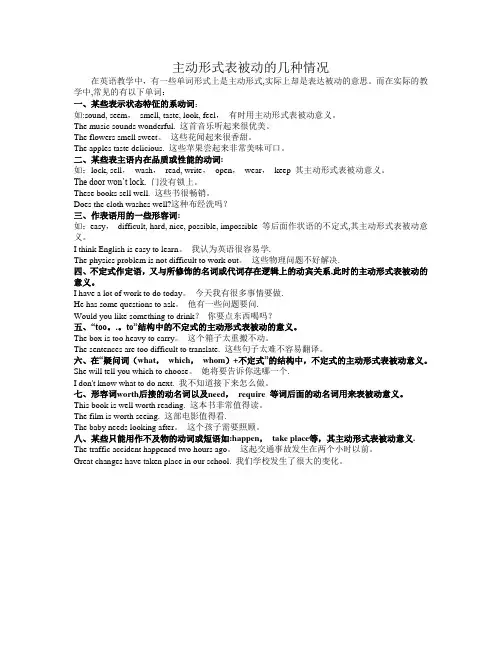
主动形式表被动的几种情况在英语教学中,有一些单词形式上是主动形式,实际上却是表达被动的意思。
而在实际的教学中,常见的有以下单词:一、某些表示状态特征的系动词:如:sound, seem,smell, taste, look, feel,有时用主动形式表被动意义。
The music sounds wonderful. 这首音乐听起来很优美。
The flowers smell sweet。
这些花闻起来很香甜。
The apples taste delicious. 这些苹果尝起来非常美味可口。
二、某些表主语内在品质或性能的动词:如:lock, sell,wash,read, write,open,wear,keep 其主动形式表被动意义。
The door won’t lock. 门没有锁上。
These books sell well. 这些书很畅销。
Does the cloth washes well?这种布经洗吗?三、作表语用的一些形容词:如:easy,difficult, hard, nice, possible, impossible 等后面作状语的不定式,其主动形式表被动意义。
I think English is easy to learn。
我认为英语很容易学.The physics problem is not difficult to work out。
这些物理问题不好解决.四、不定式作定语,又与所修饰的名词或代词存在逻辑上的动宾关系,此时的主动形式表被动的意义。
I have a lot of work to do today。
今天我有很多事情要做.He has some questions to ask。
他有一些问题要问.Would you like something to drink?你要点东西喝吗?五、“too。
.。
to”结构中的不定式的主动形式表被动的意义。
The box is too heavy to carry。

主动表被动的动词有哪些主动表被动的动词有哪些相信大家一定常常见到一些主动表被动的现象,但是,到底哪些动词可以这么用呢?不用担心,万能的小编为大家收集了一些常用主动形式表示被动意义的.动词~不定式作后置定语,放在被修饰词后面,不定式与前面被修饰的名词或代词有动宾关系,又在句子中与另一名词或代词有主谓关系,此时,不定式要用主动表被动含义。
例如:I have much work to do. 我有许多要做的事情。
(与work有动宾关系,与I有主谓关系)Jay is looking for a room to live in. Jay在找一间住的房间。
(与room有动宾关系,与Jay 有主谓关系)She has a family to support.她要维持一个家庭。
(与family有动宾关系,与she有主谓关系)Need, want, require(要求,需要),deserve (应得,值得),be worth 值得),not bear (经受不住) 后面应该接doing主动表被动。
例如:The novel is worth reading. 这本书值得一读。
The old temple requires repairing. 这座古寺庙需要修缮了。
These young seedlings will require/need looking after (=need to be looked after) carefully.这些幼苗将需要小心的呵护。
Your hair wants/needs cutting (needs to be cut).你该理发了。
不定式修饰作表语和宾语补足语的形容词时,如difficult, easy, comfortable (舒适的、安逸的),convenient(便利的,方便的),hard, cheap, expensive, 等此时结构为:主语+系动词+形容词+ 不定式;动词+宾语+形容词+不定式。
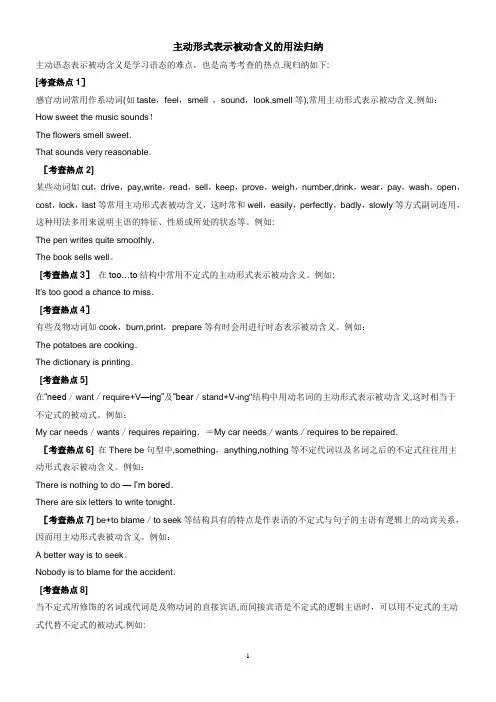
主动形式表示被动含义的用法归纳主动语态表示被动含义是学习语态的难点,也是高考考查的热点.现归纳如下:[考查热点1]感官动词常用作系动词(如taste,feel,smell ,sound,look,smell等),常用主动形式表示被动含义.例如:How sweet the music sounds!The flowers smell sweet.That sounds very reasonable.[考查热点2]某些动词如cut,drive,pay,write,read,sell,keep,prove,weigh,number,drink,wear,pay,wash,open,cost,lock,last等常用主动形式表被动含义,这时常和well,easily,perfectly,badly,slowly等方式副词连用,这种用法多用来说明主语的特征、性质或所处的状态等。
例如:The pen writes quite smoothly.The book sells well。
[考查热点3]在too…to结构中常用不定式的主动形式表示被动含义。
例如:It's too good a chance to miss.[考查热点4]有些及物动词如cook,burn,print,prepare等有时会用进行时态表示被动含义。
例如:The potatoes are cooking.The dictionary is printing.[考查热点5]在“need/want/require+V—ing”及“bear/stand+V-ing"结构中用动名词的主动形式表示被动含义,这时相当于不定式的被动式。
例如:My car needs/wants/requires repairing.=My car needs/wants/requires to be repaired.[考查热点6]在There be句型中,something,anything,nothing等不定代词以及名词之后的不定式往往用主动形式表示被动含义。
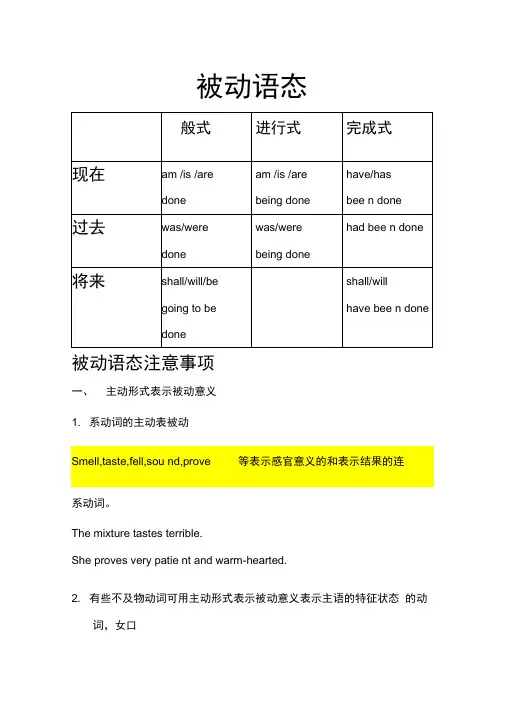
被动语态被动语态注意事项一、主动形式表示被动意义1. 系动词的主动表被动系动词。
The mixture tastes terrible.She proves very patie nt and warm-hearted.2. 有些不及物动词可用主动形式表示被动意义表示主语的特征状态的动词,女口等。
特别是后加副词well, easily等修饰时,常用主动表示被动意义This table clea nse very easily.His book does not sell well.The book won ' t shut.3. 某些表示发生(happen, take place, occur )、爆发(break out, burstout )或者“传播(spread)”的不及物动词。
The n ews that a famous sin ger would give a show spread quickly. 4. 在表示需要的词need,want,require 等词的后面,v-ing形式用主动表示被动意义The house n eeds repairi ng/to be repaired.My clothes want washi ng/to be washed.5. Worth后面v-ing用主动表示被动The picture-book is well worth readi ng.Such a man as Mr. smith is not worth help ing.二、不带to的不定式做宾语,变为被动要加上To(let除外)We saw a stra nger enter the hall.A stra nger was see n to en ter the hall.三、有些不及物动词如give,send,take,bring,get 等,变被动时加toThey gave the visitors a warm welcome.A warm welcome was give n to the visitors by them.四、有些不及物动词如buy、make find、get等,变成被动语态时,被保留的简介宾语前通常加for.My mother has bought me a computer.A computer has bee n bought for me by mother.。
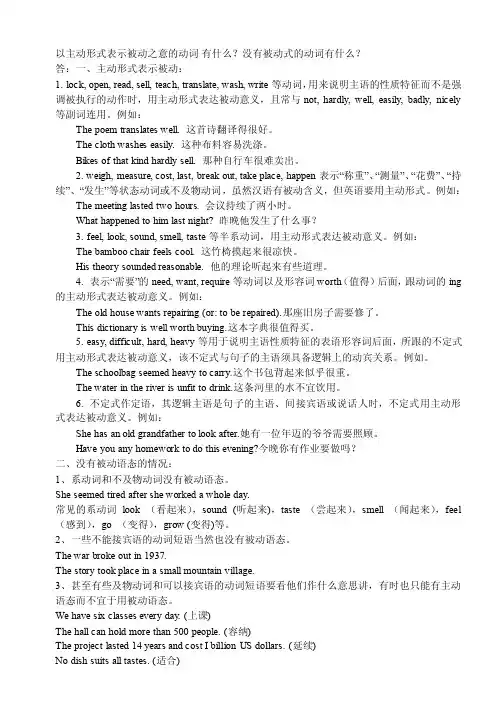
以主动形式表示被动之意的动词有什么?没有被动式的动词有什么?答:一、主动形式表示被动:1. lock, open, read, sell, teach, translate, wash, write等动词,用来说明主语的性质特征而不是强调被执行的动作时,用主动形式表达被动意义,且常与not, hardly, well, easily, badly, nicely 等副词连用。
例如:The poem translates well. 这首诗翻译得很好。
The cloth washes easily. 这种布料容易洗涤。
Bikes of that kind hardly sell. 那种自行车很难卖出。
2. weigh, measure, cost, last, break out, take place, happen表示“称重”、“测量”、“花费”、“持续”、“发生”等状态动词或不及物动词,虽然汉语有被动含义,但英语要用主动形式。
例如:The meeting lasted two hours. 会议持续了两小时。
What happened to him last night? 昨晚他发生了什么事?3. feel, look, sound, smell, taste等半系动词,用主动形式表达被动意义。
例如:The bamboo chair feels cool. 这竹椅摸起来很凉快。
His theory sounded reasonable. 他的理论听起来有些道理。
4. 表示“需要”的need, want, require等动词以及形容词worth(值得)后面,跟动词的ing 的主动形式表达被动意义。
例如:The old house wants repairing (or: to be repaired).那座旧房子需要修了。
This dictionary is well worth buying.这本字典很值得买。
英语的被动意义除了用及物动词的被动语态形式表示外,还可以用其他方法来表示,就像在汉语中并非一定要用“被”字来表示的被动意义一样。
我们把这种用法称之为“主动表被动”,下面笔者就这种可以用主动形式表示被动意义的场合归纳如下。
1.用某些不及物动词表示被动意义,如:carry, cut, drive, iron, keep, lock, open, pick, read, shut, tear, wash, wear, write等等。
这类动词既能作及物动词,也能做不及物动词。
作不及物动词时,形式上虽为主动,却表示被动意义。
例如:Meat cuts easily.肉容易切。
His novel sells well.他的小说畅销。
The car drove easily.这车很容易开。
Your pen writes quite smoothly.你的笔写起来很滑。
2.某些表示感觉动词的动词可以用主动形式表示被动意义。
例如:This shirt feels much softer than that one.这件衬衫比那件衬衫摸起来柔软得多。
That book smells old.那本书有一股霉味。
These oranges taste nice.这些橙子味道很好。
3.有少数动词(bind, cook, do, owe, print)的进行时有时有被动意义。
在这种用法中,句子的主语都一般是指物的。
例如:The magazine is binding(printing).这本杂志正在装订(印刷)。
He paid all that was owing.欠的钱他都还了。
The meat is cooking.正在火敦肉。
4.动词get, come, go之后接过去分词,表示被动意义。
get的这种用法局限于口语和非正式的书面语言,更强调动作的结果而非动作本身,并常用来表示突发性的、出乎意料的偶然事件。
而come和go常接含否定意义的过去分词。
主动形式表达被动意义小结1.lock,open,read,sell,teach,translate,wash,write等动词,用来说明主语的性质特征而不是强调被执行的动作时,用主动形式表达被动意义,且常与not,hardly,well,easily,badly,nicely等副词连用。
例如:The poem translates well.The cloth washes easily.Bikes of that kind hardly sell.2.weigh,measure,cost,last,break out,take place,happen表示“称重”、“测量”、“花费”、“持续”、“发生”等状态动词或不及物动词,虽然汉语有被动含义,但英语要用主动形式。
例如:The meeting lasted two hours.What happened to him last night?3.feel,look,sound,smell,taste等半系动词,用主动形式表达被动意义。
例如:The bamboo chair feels cool.His theory sounded reasonable.4.表示“需要”的need,want,require等动词以及形容词worth(值得)后面,跟动词-ing的主动形式表达被动意义。
例如:The old house wants repairing(or:to be repaired).This dictionary is well worth reading.5.easy,difficult,hard,heavy等用于说明主语性质特征的表语形容词后面,所跟的不定式用主动形式表达被动意义,该不定式与句子的主语须具备逻辑上的动宾关系。
例如:What life will be like in the future is difficult to predict.The schoolbag seemed heavy to carry.The water in the river is unfit to drink.6.不定式作定语,其逻辑主语是句子的主语、间接宾语或说话人时,不定式用主动形式表达被动意义。
英语中主动形式表示被动意义归纳在英语学习中,有许多地方用主动表被动,这对许多中国学生来说是一个难点,常常让他们感到不好学,不好掌握,在此小结一下。
一、Need,want,require(要求,需要),deserve(应得,值得),be worth 值得),not bear(经不住)后面接doing主动表被动。
1.The book is worth reading. 这本书值得一读。
2.The old building requires repairing. 这座古建筑需要修了。
3.These young seedlings will require/need looking after (=need to be looked after)carefully.这些幼苗将需要小心的照管。
4.Your hair wants/needs cutting (needs to be cut).你的头发该剪。
5.This point deserves mentioning. 这一点值得一提。
二、不定式作定语,放在“be +形容词+to do”的结构中,即不定式在作表语的形容词后充当状语,同时,主语是不定式结构的逻辑宾语,此时习惯上以主动形式表示被动意义。
这些形容词通常有difficult,hard,cheap,expensive,enough,sure,fit,nice,dangerous,comfortable,exciting,good,important 等。
例如:1.The problem is hard to deal with. 这个问题难以解决。
2.The bag is too heavy to carry.这包重得拎不动。
3.The sea is not fit to swim in. 这片海水不宜游泳。
4.The text is easy to understand.这篇课文容易理解.5.That article is difficult to write.那篇文章难写。
主动表被动主动形式表被动意义(1). 系动词look, sound, feel, smell, taste, appear, seem, go, prove, turn, stay, become, fall, get, grow, keep+形容词/名词构成系表结构.Eg. The steel feels cold.His plan proved (to be) practical.It has gone bad.(2). 表示开始,结束,运动的动词.如: begin, finish, start, open, close, stop, end, shut, run, movedEg. Work began at 7 o’clock this morning.The shop closes at 6 p.m. every day.(3).表示主语的某种属性特征的动词. 如: read, write, act, iron, cut, draw, drive, sell, wash, clean, wear, open, cook, lock, shut, dry, eat, drink.这类动词一般不单独使用,常有一个修饰语.Eg . This coat dries easily. Nylon clean easily.The door won’t lock. Food can keep fresh in a fridge.Your speech reads well. This material has worn thin.His book does not sell well. Your pen writes smoothly.The match won’t catch. The plan worked out wonderfully.The recorder won’t play. The engine won’t start.This knife cuts well. The cloth washes well.(4). 少数动词用于进行时,其主动形式表示被动含义.如: print, cook, fry, hang, build, make.Eg. The books are printing.The meat is cooking.(5). 介词in, on, under等+ 名词短语表示被动意义.表方位的介词于含动作意义的名词合用,含被动意义,其意义相当于该名词相应动词的被动形式,名词前一般不用冠词.常见的有:under control; under treatment; under repair; under discussion; under construction; beyond belief; beyond one’s reach; beyond one’s control; beyond our hope(我们史料不及); for sale; for rent; in print; in sight; on sale; on show; on trial; out control; out sight; out of one’s reach; out of fashion.Eg. The building is under construction.The rumor is beyond belief.His honest character is above all praise.That house is for sale.The book is not yet in print.Today some treasures are not on show in the museum.The plane was out of control.He took two days off within the teacher’s permission.(6). 不能用于被动语态的及物动词或及物动词短语:Fit, have, wish, cost, agree with, arrive at/in, shake hands with, succeed in, suffer from, happen to, take part in, walk into, belong toEg. This key just fits the lock.Your story agrees with what had already been heard.。
主动形式表示被动意义1.系动词look,sound,feel,smell,taste,appear,seem,go,prove,turn,stay,become,fall,get,grow,keep 十形容词/名词构成系表结构。
如:The steel feels cold.His plan proved (to be) practical.It has gone bad.The cloth looks good and washes well.2.表示开始、结束、运动的动词。
begin, finish ,start,open,close,stop,end,shut,run,move等。
如:Work began at 7 o'clock this morning·The shop closes at 6 p.m.every day.3.表示主语的某种属性特征的动词。
如read,write,act,iron,cut,draw,drive,sell,wash,clean,wear,open,cook,lock,shut,dry,eat,drink。
这类动词一般不单独使用,常有一个修饰语。
如:This coat dries easily.这种外衣容易干。
Nylon cleans easily.尼龙容易洗干净。
The plan worked out wonderfully. 这计划制定得很好。
Your pen writes smoothly.你的笔好写。
Your speech reads well.你的演说讲得好。
This material has worn thin.这个材料已经磨薄了。
This book sells well. 这本书畅销。
His book does not sell.他的书没有销路。
Food can keep fresh in a fridge.食物在冰箱里能保鲜。
用主动形式表示被动意义的词
1. 感官性动词 feel , look , smell , sound , taste 等无被动形式,要用主动形
式表示被动意义。
如: Cotton feels soft. The flowers smell sweet.
2. 英语中有些不及物动词和词组,只有主动形式,常被视为主动形式表示被动含义。
常见
有的: happen , take place ,break out, come about , come out等。
如:1) What has happened over there ? 2)How did it come about ?
3. 有些表示静止状态的及物动词或动词短语不能用于被动语态,须用主动形式表示被动
意义。
常见的有have , cost , lock , last , own , suit , hold , fit , join ,consist of , belong to , agree with 等。
如:1) The book costs 150 yuan. 2) Does the key fit the lock ? 3)Your statement lacks detail.
4. 一些常见的动词如 cut , drive , drink , keep , number , open , pay , prove ,read , sell , wash , wear , weigh , write也常用主动形式表示被动意义。
如:1)The matter will keep until morning. 2) The dictionary sells for 50 yuan.
3)The pen writes quite smoothly.
5. 动名词主动形式表示被动意义的情况:
( 1 ) worth 的主语通常是物,但其后面跟动名词的主动形式表示被动意义,不能接不定
式的被动式。
如: The book is well worth reading.
( 2 )动词 need , require , want 作“需要”解时,其后跟非谓语动词作它的宾语时,必须用动名词的主动形式表示被动意义,相当于不定式的被动式。
如: The window needs / requires / wants cleaning / to be cleaned.。